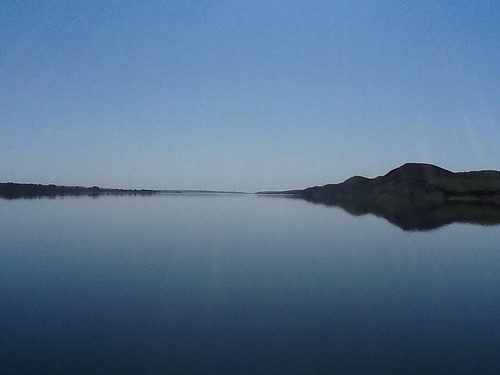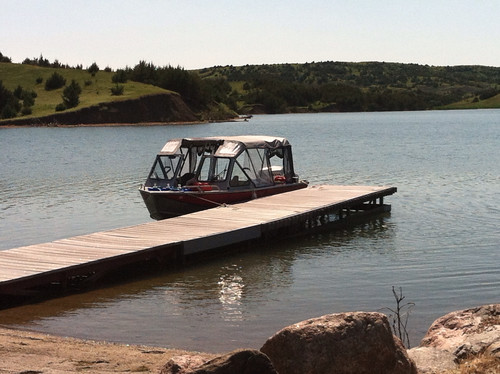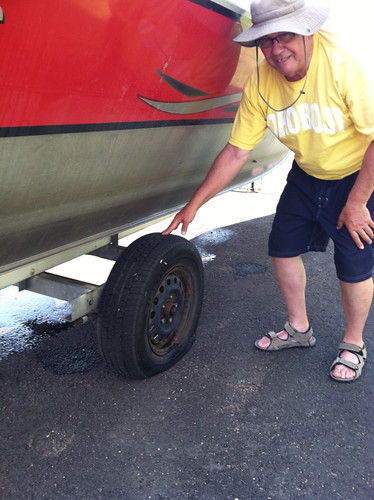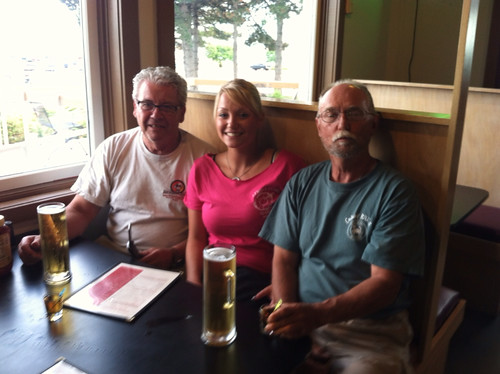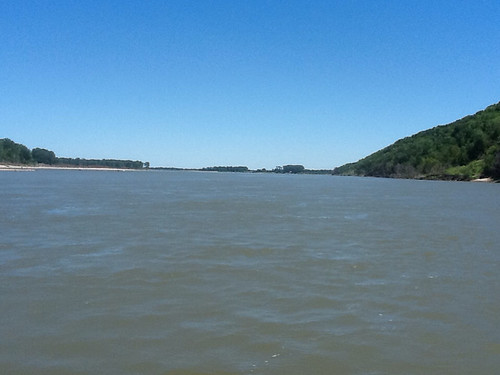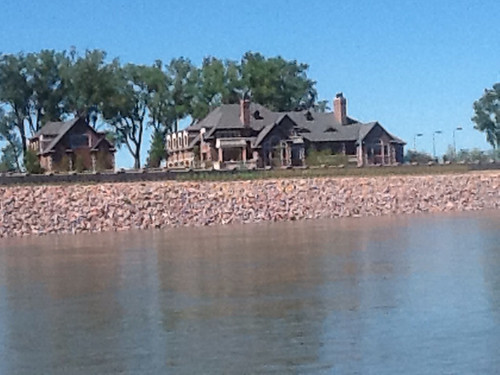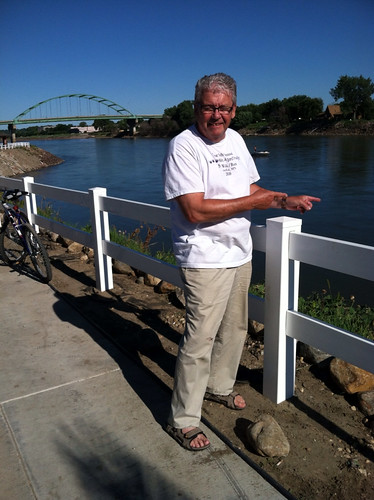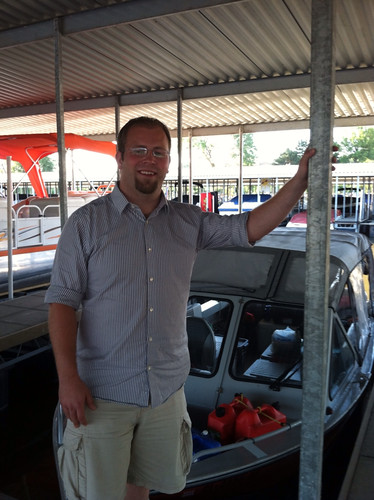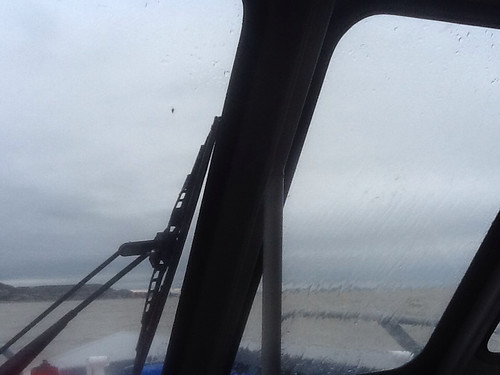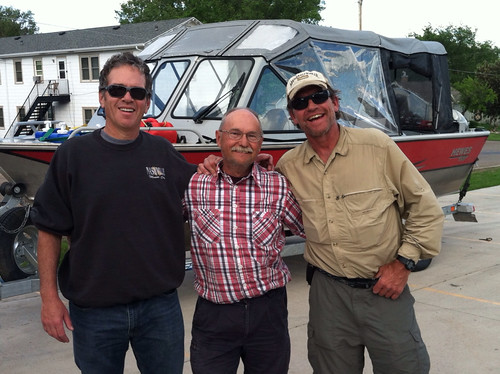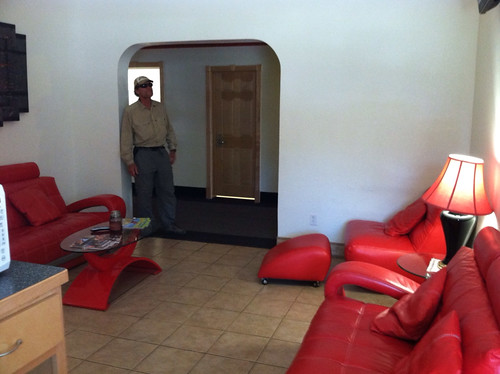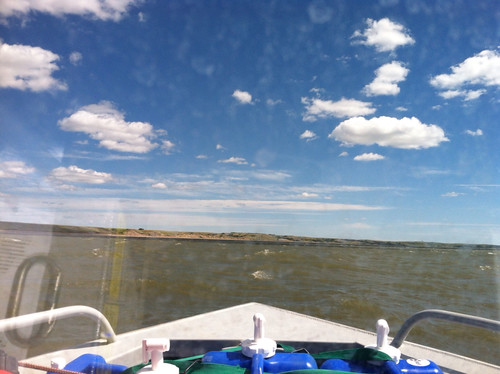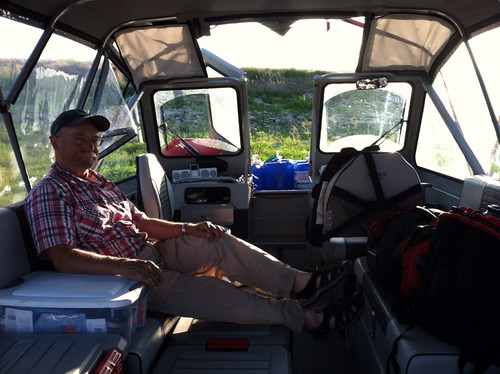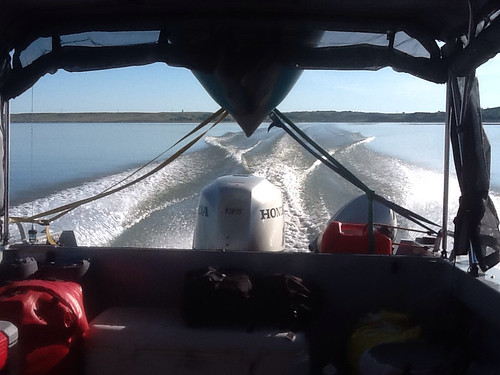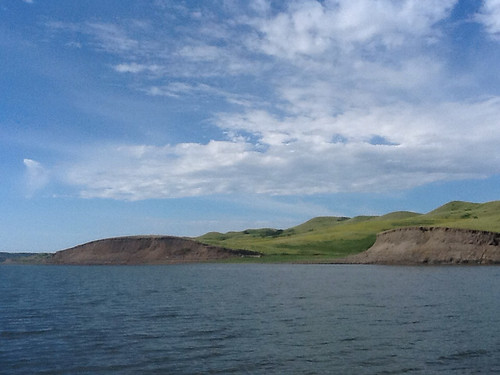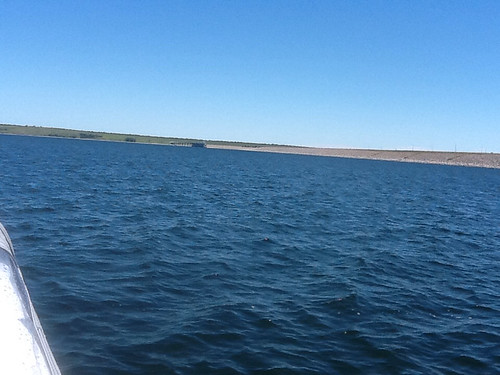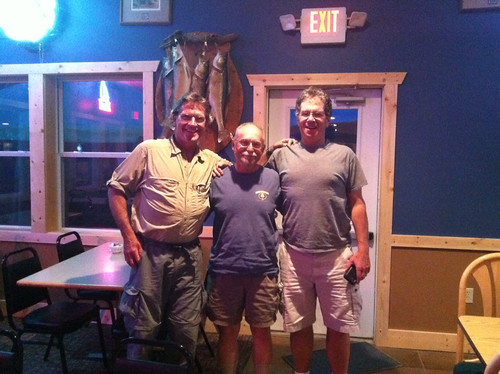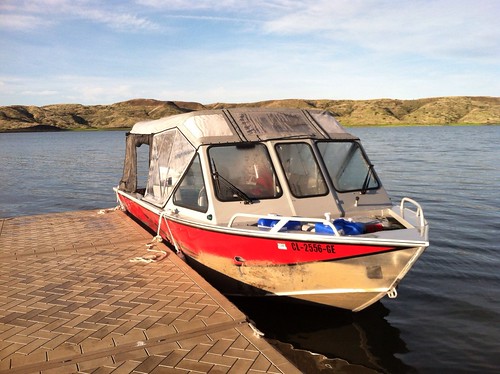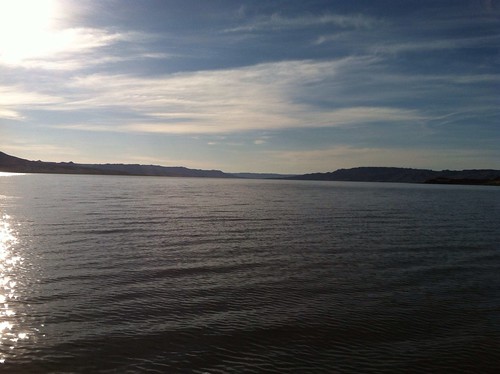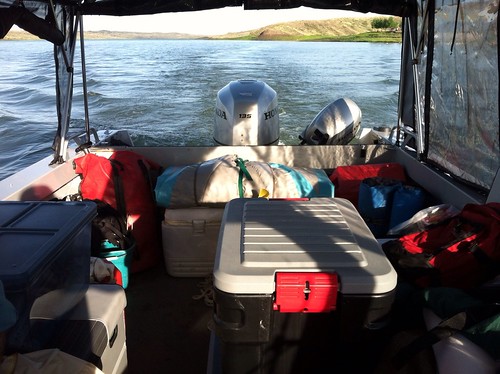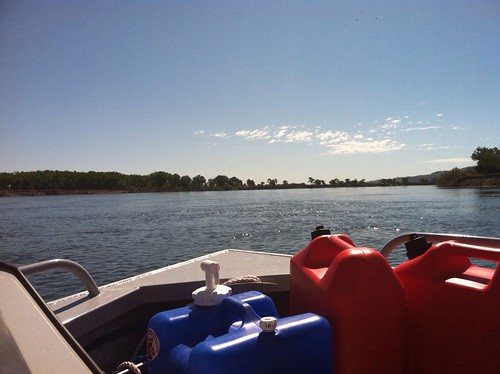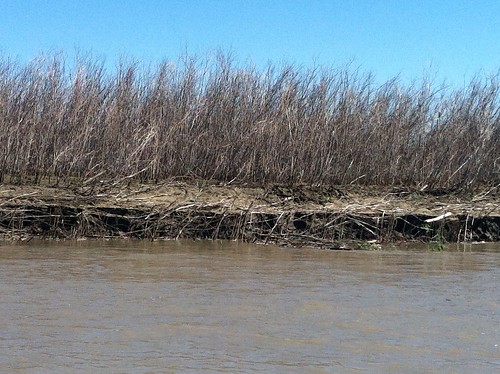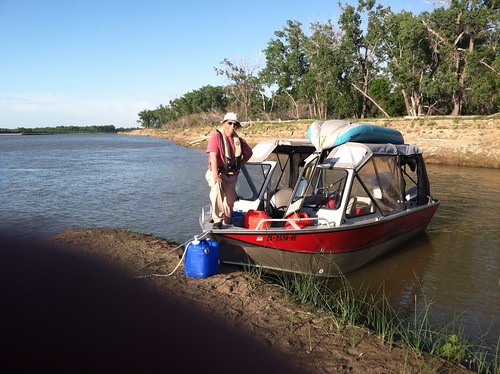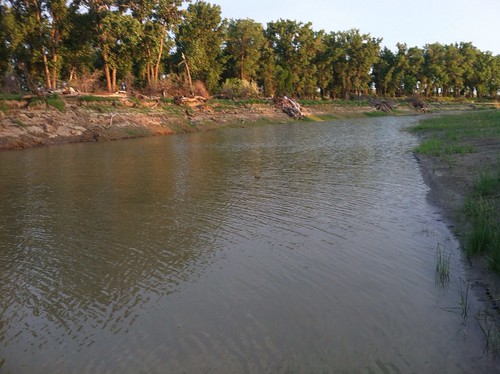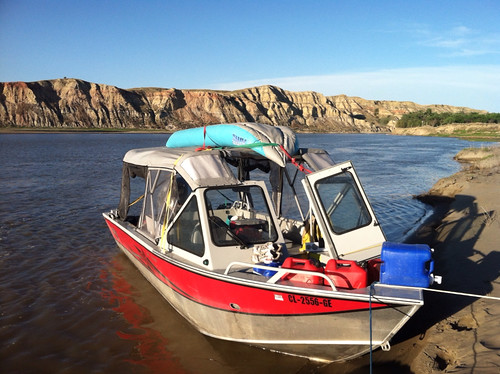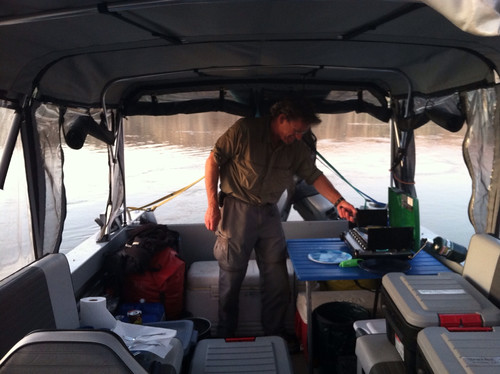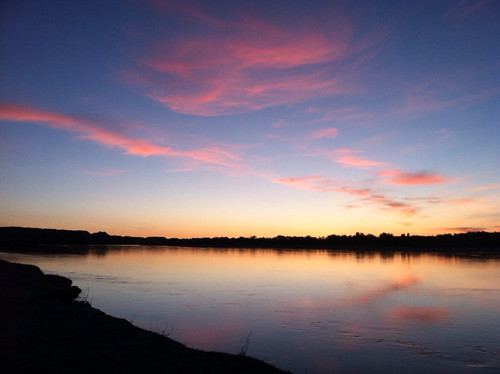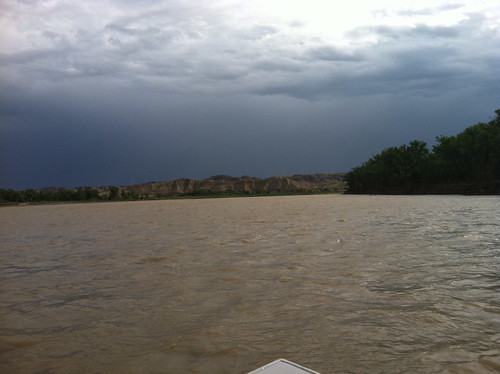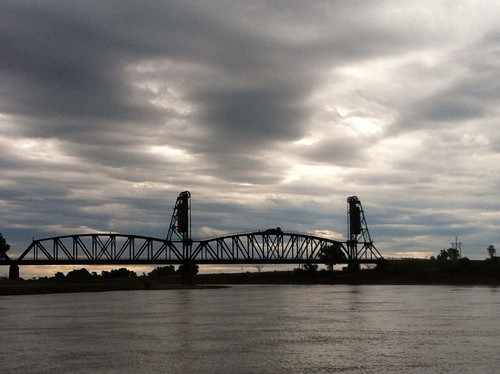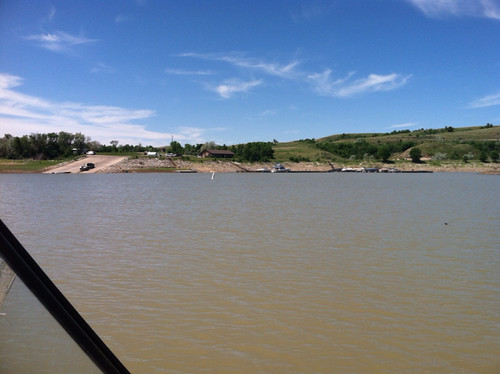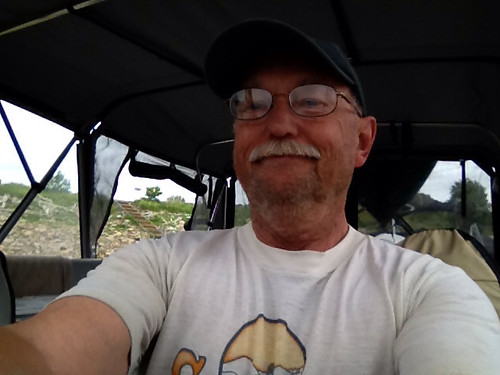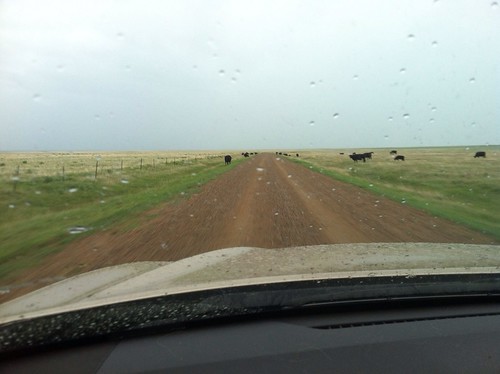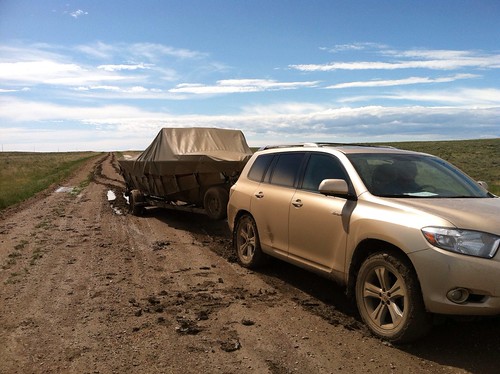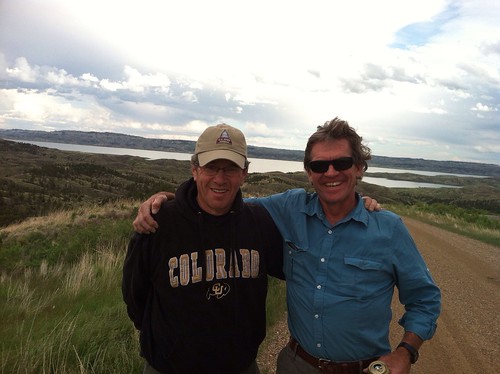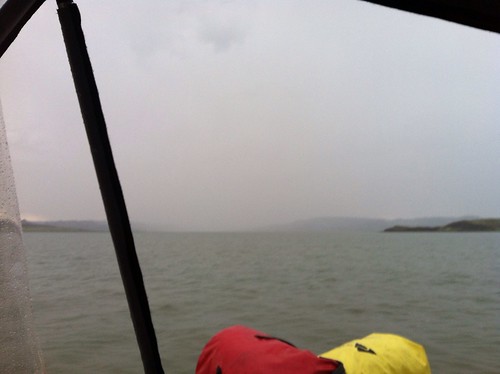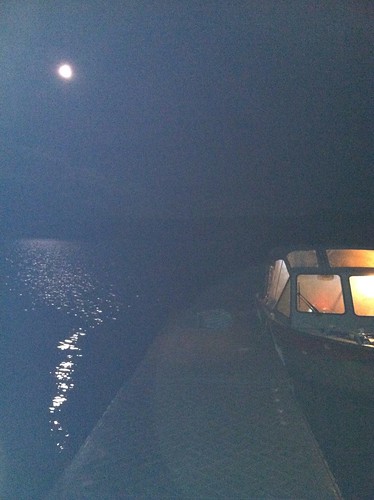Larry and I Get 'er Done
Sunday afternoon Larry Lavin arrived, driven over by his friend Carol from southwestern Minnesota. We loaded his gear on the boat at the Oahe Marina, agreed on a time to meet in the morning, and they went back across the river to Pierre. I thought Carol posed a very interesting question: "What has surprised you the most"? I replied that the seriousness of the phrase "pick our way" through the shallow river reaches since Montana surprised me the most. Larry was to be similarly impressed in the days to come.
Day 16. After replenishing gas and ice, and getting a late update from marina owner Steve and a visiting ranger, we launched and headed south. The wide bay we soon traversed was beautiful in the clear morning.
We went through a narrow chute where Antelope Creek carried a lot of sediment into the river, which was a problem area Steve had warned us about, but we followed some fishermen and found our way out into the main channel without incident. We were into deeper water in Lake Sharpe in a short time. Larry took the helm and jumped the boat on plane and made good time down to the Big Bend Dam. Larry has been a boat guy in the lakes around Okoboji, Iowa, for decades, so had complete comfort working with Little Sadie.
The terrain around the lake was fairly hilly and somewhat wooded, and very lovely where we pulled into the boat ramp at Big Bend. That was a good thing, because we were to spend a little time there.
We contacted the local fellow with whom we had arranged portage, and got out of the heat in a picnic pavilion nearby. After some time, Pat Koster pulled up towing a trailer. But it was just a little trailer, suitable maybe for loading Pogo's flat-bottom fishing pirogue. Communication is a tough business. But Pat was undaunted. He made a couple of calls and took off to get a trailer big enough for a 20-foot V-hull wide boat. After some more time went by, and a follow-up call by Larry, Pat arrived with a bigger trailer. He backed it into the water and Larry drove the boat up onto it. I stood to the side, looking at the neat circle of bubbles coming up from around the wheel rim on the right wheel. By the time the rig was pulled up onto flat ground, the tire was entirely flat.
Pat was undaunted. With the front of the trailer perched precariously on a car tire jack, he went for another wheel. After some time he returned, changed the tire, and took us around the dam to a ramp at a downstream campground. There was no one around because the campground had been inundated by last year's flood and was still closed. We ended up thinking Pat was a trouper. Despite repeated stumbling-blocks due to bad equipment, he had stayed in the game -- focused, diligent, polite, good-humored, and very hard-working. He is a jack-of-all-trades, supporting his family doing odd jobs (sounds like about three at a time), with a rock-solid work ethic. Our kind of guy. We didn't mind that the portage operation had taken three hours.
We beached the boat in a little protected cove, nosing the bow up onto the bank a bit, so it would be somewhat stable. We tied off, set up the table and cooking gear, and had one of Larry's batches of chili for supper. Marvelous recipe. We moved things around, from cooking to sleeping configuration (which is by now a well-practiced routine) and turned in. The enclosure was buttoned up against the wind and the possibility of rain.
Day 17. During the night we had the impression that the boat was a little lower in the stern, because our crossways bunks were a little inclined that way. In the morning we found the reason. Since the dam release was cut back, the water level had dropped most of two feet, and we were as high and dry as Noah's ark in those fanciful pictures you'd see in tabloids of it supposedly being discovered on a remote mountaintop.
We thought that the water level would come back up when they started the daily release of water from the dam, but we didn't know when that was or how soon it would float us. Apparently that schedule is related to the need to generate more electricity to meet the peak (air-conditioning) usage, in whatever market the dam is serving. In our experience, water level was expected to come up by mid-morning. So, we had a leisurely breakfast with eggs and coffee, did dishes and got ready to go. The water was not rising very much very fast. Fortunately, we saw a group of five men up in the parking lot, and Larry applied his winning ways to enlist their help. (I learned this great intro when asking for help: "Have you done your good deed for today"? Works every time.) It was all that six of us could do, with Larry revving the engine in reverse, to launch the boat, but we eventually did. We bid our thanks and goodbyes and left Ft. Thompson.
We had good water for the 60 miles or so before getting into Lake Francis Case, not long after running under the bridge at Chamberlain.
Clouds were building, but the lake was not rough, so Larry jumped the boat up on plane and we made a fast run to Ft. Randall Dam at Pickstown. Cory Donlin from Donlin Marine, a local boat sales and service shop, picked us up, ran us by a gas station to refuel the boat, and stopped into their store. His dad Chris was very helpful with information about the seriously difficult river reaches we would encounter the next day, and about a nice protected cove we could duck into for the night below the dam. As predicted, a storm blew through about four in the morning, with blasting wind and driving rain. Again, things were a little damp around the edges but the boat top did quite well. It was good that we were tied up to an old homemade houseboat and somewhat sheltered from the wind and waves.
Day 18. The next morning we set things out to dry while we contemplated the weather report. I told Larry I was very fearful about this stretch. Brother George had warned about the area around Springfield, and my concern was that with wind and/or rain roughing up the river surface, it would be doubly hard to get clues about where the channel now went. Larry was more confident, so we set out. Most of the day the weather was not bad, though we did get into a rainstorm in the afternoon, and did have to fight our way off sandbars on several occasions. The last of that stretch, the inflow to Lewis and Clark Lake, was a confusing maze of shallow channels threading through many small islands. Without George's waypoints pointing the way, we would never have found our way through it.
We finally got out on the lake, greatly relieved, and I picked up speed to run down to the dam. Before I could spot it happening on the depth finder, WHAM! -- I ran us aground. After some work we got off the sandbar and went on. It turned out that the lake was surprisingly shallow, so it took some time to work our way to the dam at Gavin's Point. We were happy to go into a nice marina there, gas up, park the boat, and head up to the Marina Grill for supper. We celebrated getting through what was expected to be the sketchiest stretch of river Larry and I would see. Our waitress Ashley was good company as we celebrated and had a nice meal.
On our way out we had a nice visit with Steve and Tina Kümmel, a couple visiting the river from eastern Nebraska. After hearing our story, Steve gave me his good wishes for the trip and a $20 bill, to be used to celebrate this week's part of the journey. We slept well under clear skies in the marina.
Day 19. The next morning we got the marina folks to portage us down below the dam and started out on the last river stretch before it starts being maintained by the Corps of Engineers, at Sioux City. We expected this to be much less of a sandbar-hazard section than the previous day,and be a relatively trouble-free 75 miles. We were now on the part of the river that separates South Dakota and Nebraska, and fairly soon passed under the bridge at Yankton, SD.
This day turned out to be the hardest challenge yet. The flood last year had blocked passages where the traditional channel had gone, so several times the waypoints displayed on the GPS had to be abandoned, and we were just on our own to find a channel. We ran aground or backed out of dead-end shallows numerous times. The mileage to Sioux City was very hard-won. The river often looked benign, but was laden with problem spots.
As we approached Sioux City, the last fifteen miles saw the river narrower and deeper, and the flood wreckage we saw above was replaced by miles of beautiful homes.
We were ecstatic to finally, in late afternoon, pull into the marina, gas up, and know that we had finished up the most harrowing part of my journey -- the natural, unmaintained river reaches in the dammed (sic) upper Missouri River. We enjoyed watching the boating fun going on in the river while waiting for Larry's son Philip to arrive to pick him up.
After a celebratory beer with Philip, we loaded out Larry's stuff and I sent them on their way. Larry and I had been close-quarters camping for most of a week, and shared many teeth-grinding challenges and a lot of laughs. We are now more Good Buddies than ever.
I secured things on the boat, and moved from the marina to the hotel next door, where I would have the next four days off while waiting for my next XO, my nephew Randy, to arrive. In my room I looked in the mirror for the first time in days, and reflected that I really was starting to look the part -- a gnarly old river rat.
Day 20 thru Day 22. After a good night's sleep I started making preparations for people and places downstream. As the sun came up, I looked out my window, up the river. Right before me was one of the little blue river mile markers, announcing that I was at mile 733 above the mouth of the Missouri. Three weeks and 1,115 miles had gone by since Little Sadie went in the water in Montana.
Who hears the rippling of rivers will not utterly despair of anything. -Henry David Thoreau
Sunday, June 24, 2012
Saturday, June 23, 2012
Day 7 thru Day 14
Lotsa Lake from Here to Pierre
"Jon. Jon. Lightning storm. It's a different deal". This greeting at about three in the morning from chase car driver John, who has been doing a bivouac out on the dock next to the boat. We let him in, secured the boat better, and zipped it all up as the mother of all lightning storms moved over us. We all lay there for a long time watching the most fantastic light show I have ever seen. It was a horizon-to-horizon web of dancing lightning on all sides, moving slowly over us from west to east. As it came over, strong gusts blew rain in through small joints in the boat's tent cover, so we were a little damp around the edges, but I was generally pleased with how the top performed. Pea-size hail hammered on us after the rain, but did no damage.
After the storm we all got a few more hours' sleep, and got up to a cloudy and windy morning. We deliberated for a couple of hours about getting out into Lake Sakakawea, because of the danger of unmanageable waves. We finally decided to make a run for it when the wind calmed a bit, agreed to meet John down at the dam in a couple of days, and headed out into the lake. It was slow going for a while in 2-3 foot waves, but the wind seemed to be steady.
After a time the wind moderated, and we made a good long run down the lake. Sak is a huge body of water, about 130 miles long and sometimes 4-5 miles wide. If the wind comes up, small boats can be in real trouble, so we were happy to have the weather settle down. We made 90 miles to the Indian Hills Resort, which earns its reputation as one of the best stops on Lake Sak. Kelly and Carol, the ladies running things there, were great hosts and offered good information. We got gas, took showers, and settled in for dinner and a good night's sleep.
We did notice that this area seems to have a strong fishing culture. The kids (practically toddlers to teens) in a couple of families stayed at it for hours, 'til near dark. We were happy that from time to time one of them would pull in a fish. All along through the Dakotas we were to see this fishing focus and hear the refrain: "What, you ain't fishin? Okay den. . .Well, whataya doin?"
George spent some time getting the VHF radio operating, and got it going with local area weather channels, which would be useful every day as we ran ahead of storms. As part of the procedural setup he demanded that I stop deliberating and settle on a name for the boat (to properly report in case of an emergency). I had pretty well gotten there in my deciding, so announced that the boat (which had already taken on a feminine entity) is Little Sadie, after my granddaughter. Here's Rachel's and Brian's little Sadie Caroline.
The next day we made good progress in moderate seas down to Garrison Dam, completing Sak and having John take the boat out and move it to the hotel in Riverdale. We had managed to get clear of another big lake without a weather delay, so were all happy campers.
Now this hotel, the only game in the twin towns of Riverdale and Pick City, was probably the most interesting hotel I can recall staying in. The rooms are spacious and nice, and the beds are great. It is in a building renovated from the old high school, and someone has spent a lot of money decorating, furnishing, painting, etc. But someone in the mix really likes red and black (maybe the high school colors?). So the halls were trimmed in red and black, and the lounge - reading room was dressed out in red. Kind of fun, in a way.
The hotel has a nice bar and grill, with a totally international waitstaff. We speculated about all kinds of scenarios, until one of the girls explained that they bring in college girls in an exchange student program drawing from all over the world, rotating through in three months or so. It was a nice program, the girls seemed to enjoy the interaction with each other, but getting the right beer ordered required some patience.
The next morning we awoke to high winds, and readily agreed that it was a no-go day. We found out that we could replace the oil in the helm with power steering fluid, and when we drove across the dam to buy some in Pick City, the lake looked like the ocean.
This steering thing was getting serious. Response of the motor turning with the wheel was getting slow and stiff and sluggish, and we had a lot of steering-intensive sandbar dodging yet ahead of us. We set up office at a table in the bar, and started to work. The result was surprisingly heartening. I called Dave Hewes at Hewes Marine out in Washington state, and explained what we were doing, where we were, and the probability of serious consequences if the steering went south. He without hesitation rallied his resources and they went to work. George explained the details to Bryan, their warranty manager, and he decided to send a new helm assembly to a boat shop downstream. By the end of that day he had sent out the equipment to a shop my friend Larry in Iowa had located in Bismarck, ND, to arrive about when we would. I told Mr. Hewes that this was an over-the-top service response that is seldom seen today.
The next morning the weather was better, so we topped up the steering fluid and launched the boat below the dam, agreeing to meet John in Bismarck. I did a morning of piloting down the river, working through some tricky sections, and George brought us into a boat ramp above town by late afternoon. We loaded the boat on the trailer and the three of us went to Days Inn. We walked up the street looking over the several restaurant choices, and readily chose Space Aliens. This was a fun bar and grill dressed out with flying saucers and futuristic trimmings and alien creatures. We were well fed on excellent burgers and ribs, and enjoyed the long walk back to the motel in the cool evening.
The next morning we got ready to go for our appointment at River City Sports, and no one could come up with the car key. In my haste in preps for the trip I had neglected to get a spare, and now Murphy had seen his opening. We took everything in the motel room and boat apart, and had AAA on the way, when John called Space Aliens and (whew) they had it. Needless to say, we left town with three strategically-placed car keys.
We dropped the boat off at the shop and were astounded to get the call in an hour and a half that it was ready. Larry, their service manager, had jumped in and handled it -- matching the excellent support we had gotten from Hewes Marine. We were very impressed. The rest of the day was spent catching up on logistics and downriver planning and we were ready to launch early.
We had many challenges the next morning in the river, getting into sandbar cul-de-sac fixes, and at one point retreating hundreds of yards upstream to find a way to some semblance of a channel. When we finally moved into open water at the inflow to Lake Oahe, we were delighted, in spite of increasing wind and chop.
We spent several hours motoring through 2-3 foot waves off our rear quarter, timing our speed to match the waves and minimize the pitching and rolling. The boat is very seaworthy, but more speed would have been punishing. We made about one-fourth of the lake's 250-mile length that day, and were fatigued when we ducked into Beaver Bay and found a nice sheltered spot to tie up behind a highway embankment for the night. I enjoyed being able to slouch a while before we cooked up another of Nan's fine dinners. This was the last of them, and our ice supplies and strict cooler management had allowed it to travel in good shape for a full two weeks.
This was the end of George's leg of the trip, as he and John both had to get back to Denver to meet other obligations. We got together for dinner at the marina grill that night and celebrated getting through the most challenging part -- the first 775 miles -- of this voyage.
After a good night's sleep on the boat, I had a quiet Sunday in the marina, looking forward to the arrival of my next Executive Officer (XO), my friend and my son Adam's father-in-law, Larry Lavin of Lake Okoboji, in northwest Iowa. It was a good day to relax and regroup.
"Jon. Jon. Lightning storm. It's a different deal". This greeting at about three in the morning from chase car driver John, who has been doing a bivouac out on the dock next to the boat. We let him in, secured the boat better, and zipped it all up as the mother of all lightning storms moved over us. We all lay there for a long time watching the most fantastic light show I have ever seen. It was a horizon-to-horizon web of dancing lightning on all sides, moving slowly over us from west to east. As it came over, strong gusts blew rain in through small joints in the boat's tent cover, so we were a little damp around the edges, but I was generally pleased with how the top performed. Pea-size hail hammered on us after the rain, but did no damage.
After the storm we all got a few more hours' sleep, and got up to a cloudy and windy morning. We deliberated for a couple of hours about getting out into Lake Sakakawea, because of the danger of unmanageable waves. We finally decided to make a run for it when the wind calmed a bit, agreed to meet John down at the dam in a couple of days, and headed out into the lake. It was slow going for a while in 2-3 foot waves, but the wind seemed to be steady.
After a time the wind moderated, and we made a good long run down the lake. Sak is a huge body of water, about 130 miles long and sometimes 4-5 miles wide. If the wind comes up, small boats can be in real trouble, so we were happy to have the weather settle down. We made 90 miles to the Indian Hills Resort, which earns its reputation as one of the best stops on Lake Sak. Kelly and Carol, the ladies running things there, were great hosts and offered good information. We got gas, took showers, and settled in for dinner and a good night's sleep.
We did notice that this area seems to have a strong fishing culture. The kids (practically toddlers to teens) in a couple of families stayed at it for hours, 'til near dark. We were happy that from time to time one of them would pull in a fish. All along through the Dakotas we were to see this fishing focus and hear the refrain: "What, you ain't fishin? Okay den. . .Well, whataya doin?"
George spent some time getting the VHF radio operating, and got it going with local area weather channels, which would be useful every day as we ran ahead of storms. As part of the procedural setup he demanded that I stop deliberating and settle on a name for the boat (to properly report in case of an emergency). I had pretty well gotten there in my deciding, so announced that the boat (which had already taken on a feminine entity) is Little Sadie, after my granddaughter. Here's Rachel's and Brian's little Sadie Caroline.
The next day we made good progress in moderate seas down to Garrison Dam, completing Sak and having John take the boat out and move it to the hotel in Riverdale. We had managed to get clear of another big lake without a weather delay, so were all happy campers.
Now this hotel, the only game in the twin towns of Riverdale and Pick City, was probably the most interesting hotel I can recall staying in. The rooms are spacious and nice, and the beds are great. It is in a building renovated from the old high school, and someone has spent a lot of money decorating, furnishing, painting, etc. But someone in the mix really likes red and black (maybe the high school colors?). So the halls were trimmed in red and black, and the lounge - reading room was dressed out in red. Kind of fun, in a way.
The hotel has a nice bar and grill, with a totally international waitstaff. We speculated about all kinds of scenarios, until one of the girls explained that they bring in college girls in an exchange student program drawing from all over the world, rotating through in three months or so. It was a nice program, the girls seemed to enjoy the interaction with each other, but getting the right beer ordered required some patience.
The next morning we awoke to high winds, and readily agreed that it was a no-go day. We found out that we could replace the oil in the helm with power steering fluid, and when we drove across the dam to buy some in Pick City, the lake looked like the ocean.
This steering thing was getting serious. Response of the motor turning with the wheel was getting slow and stiff and sluggish, and we had a lot of steering-intensive sandbar dodging yet ahead of us. We set up office at a table in the bar, and started to work. The result was surprisingly heartening. I called Dave Hewes at Hewes Marine out in Washington state, and explained what we were doing, where we were, and the probability of serious consequences if the steering went south. He without hesitation rallied his resources and they went to work. George explained the details to Bryan, their warranty manager, and he decided to send a new helm assembly to a boat shop downstream. By the end of that day he had sent out the equipment to a shop my friend Larry in Iowa had located in Bismarck, ND, to arrive about when we would. I told Mr. Hewes that this was an over-the-top service response that is seldom seen today.
The next morning the weather was better, so we topped up the steering fluid and launched the boat below the dam, agreeing to meet John in Bismarck. I did a morning of piloting down the river, working through some tricky sections, and George brought us into a boat ramp above town by late afternoon. We loaded the boat on the trailer and the three of us went to Days Inn. We walked up the street looking over the several restaurant choices, and readily chose Space Aliens. This was a fun bar and grill dressed out with flying saucers and futuristic trimmings and alien creatures. We were well fed on excellent burgers and ribs, and enjoyed the long walk back to the motel in the cool evening.
The next morning we got ready to go for our appointment at River City Sports, and no one could come up with the car key. In my haste in preps for the trip I had neglected to get a spare, and now Murphy had seen his opening. We took everything in the motel room and boat apart, and had AAA on the way, when John called Space Aliens and (whew) they had it. Needless to say, we left town with three strategically-placed car keys.
We dropped the boat off at the shop and were astounded to get the call in an hour and a half that it was ready. Larry, their service manager, had jumped in and handled it -- matching the excellent support we had gotten from Hewes Marine. We were very impressed. The rest of the day was spent catching up on logistics and downriver planning and we were ready to launch early.
We had many challenges the next morning in the river, getting into sandbar cul-de-sac fixes, and at one point retreating hundreds of yards upstream to find a way to some semblance of a channel. When we finally moved into open water at the inflow to Lake Oahe, we were delighted, in spite of increasing wind and chop.
We spent several hours motoring through 2-3 foot waves off our rear quarter, timing our speed to match the waves and minimize the pitching and rolling. The boat is very seaworthy, but more speed would have been punishing. We made about one-fourth of the lake's 250-mile length that day, and were fatigued when we ducked into Beaver Bay and found a nice sheltered spot to tie up behind a highway embankment for the night. I enjoyed being able to slouch a while before we cooked up another of Nan's fine dinners. This was the last of them, and our ice supplies and strict cooler management had allowed it to travel in good shape for a full two weeks.
The next day was sunny and Oahe was smooth as glass. We put the boat up on plane and made the sixty-odd miles to Mobridge, SD by lunchtime. The Honda 4-stroke just hummed along.
We stayed at Bridge City Marina, below town, and enjoyed getting to know the new owner, Mike Norden. Mike was rebuilding and improving the marina after the huge flood last year. We would continue to hear stories related to that flood all along the river. We stayed with John that night in a motel in town, and all three of us had walleye for dinner, for the first time ever. It is a very tasty fish, which we don't have in Colorado. I liked it so much that I ordered it the next night as well.
There was some chop on the lake the next morning, but we wanted to get to Oahe Dam at Pierre that day, so motored along aggressively through one-foot waves. Banging through waves sounded like we were hitting sunken trees, but Little Sadie slammed along like a tank.
We came to the dam by early afternoon, met John, and portaged the boat to the Oahe Marina and Resort, below the dam. This was the nicest, most full-service marina we had seen, with a good bar & grill, store, laundry, and showers in the adjacent campground. Steve Rounds, the owner, had just put in boat slips in their lagoon this year, as part of the renovation after last year's flood. Steve is a very nice guy, who took an active interest in getting me the best information on hazards that might exist downstream.
Sunday, June 17, 2012
Day 1 thru Day 6
[Editor note - Ongoing internet access & technical issues have precluded blogging most of past three weeks. Now in position to gain on that. Sorry for delay. JI]
Williston Run - 240 Miles of Clenched Teeth
Weather was clearing off to the east when George and I awoke, had coffee and cold breakfast stuff (our standard fare), and a taste of champagne to celebrate the launch of the journey. With Eric Clapton/JJ Cale "Down the River" blaring on the sound system and exuberance overflowing, we cast off and started out of our bay into the expanse of Ft. Peck Lake. The boat was muddied up from the day before, but the mild chop took care of that.
Very soon we started learning what running these river reaches would entail. From our starting point yesterday to the beginning of the channelized (Army Corps of Engineers maintained) lower Missouri, at Sioux City, Iowa, is a little over eleven hundred miles. Something like five hundred miles, before getting into open lake water on the half-dozen huge reservoirs, is raw river. The most challenging stretch was expected to be this first one, about 240 miles to the inflow to Lake Sakakawea near Williston, ND. The width varies greatly, and wide means shallow. The traditional channel is very hard to pick out, and staying in water deep enough for our boat (about 1 1/2 feet) required constant vigilance.
George did the piloting these first days because he had substantial experience running rivers in powerboats and rafts, and a well-developed sense of where the channel might be and where hazards lurked. We have a wonderful Lowrance GPS/depth finder, armed with old channel waypoints that George had laboriously plotted and fed into the unit so they displayed and we could follow. Even with this invaluable guide, since the river is always changing, we still had to constantly work around (and off) underwater sandbars. My job was to watch for signs of sand or hazards in the water, as well as clues to where the fastest flow was. Also I would run back and report how deep our prop was set, to optimize sneaking over shallows -- or blasting back out of them. See the intense concentration of the pilot.
The big events of the first day were when we ran through two sets of rapids (happily the last we were to encounter). We ran through the first with some scraping and a bit of customizing the propeller. After that it was designated the River Prop, which we would change out with the Lake Prop when transitioning from a river reach to a lake transit. But the second rapid was shallower. We started through and BANG hit a sizable rock. We spun sideways, and the boat listed 20-30 degrees as the 5 mph current pushed us against the rock. I thought OMG as they say, and expected we would spend the night there. But, pushing backward with the boat hook and paddle, and racing the engine in reverse, we managed to slide off and float down through the rapid. Backwards, which is not ideal. But, the prop was pulled up and we floated free. I thought my teeth were permanently clenched.
Soon after the rapids excitement, we pulled into a little cove and celebrated ending the first day with a coupla beers, still afloat and moving forward through the 240 miles to Williston. Here's happy Jon. By the way, the rubber duckie tied on top is Lolita. She is there in case one of us would have to go first, taking soundings and leading the boat through where no channel might be found. Or in the worst case we could ride Lolita out and send a large helicopter with grappling hooks back to pull the boat up out of mud flats somewhere. (That had been my nightmare scenario for months. In the coming days it would continue to look like a possibility.)
The rest of the week was a series of long days in which both of us were preoccupied with the task of finding enough water, mile after mile, to keep moving the boat downriver. Sandbars were endless, and it was slow going most of the time. Sometimes we made only about 35 miles in a day. The tools were the waypoints on the GPS, the depth finder, and clues such as visible current, Indian soap (bubbles of foamy white protein material on the surface) and debris being drawn along on the fastest water, and the general tendency of a river to "pinball" from one shore to the other and cut out around the outside bank on a curve. Places not to go were suggested by visible trees in the water, disruption in the current, funny wave action, linear stretches with change in water color, brown water, and the like. By midweek I started cutting my teeth on piloting in these conditions. It was very frightening to get into one foot of water and struggle around trying to escape, particular when it seemed that I was in a cul-de-sac and surrounded by shallows. Gradually skill and confidence built.
When we could catch our breath and look around, the scenery was beautiful. The river was trimmed with mature cottonwood stands, and in the distance there were occasional majestic bluffs.
We saw a variety of wildlife, including geese, eagles, even wild mustangs on the Ft. Peck Indian reservation. But there were no people for days, save a couple of boats with Fish and Game guys doing field work. It was interesting to see that the mama geese flew away as we approached, leaving their goslings to fend for themselves. They would typically dive and swim away, but we had to stop the prop and float by a few times.
At the end of the day we tied off to the bank, ideally in slack water but not always. We found that a good technique was to set two anchors onshore, at ninety-degree angles from one another. The boat would swing as it pleased, but this was a very secure mooring. One night we were backed by an impressive bluff, made finer as the setting sun cast shadows through it.
After we got settled in, we would have dinner, and these were meals George's wife Nan had prepared for this first section of the trip, shrink wrapped and frozen. Delicioso!
This particular night the sunset was pretty spectacular.
And then the storm came, with a fair amount of wind and lightning and rain, but the boat enclosure seemed to do very well.
Near the North Dakota border we passed the mouth of the Yellowstone River on our right, and it added very significant flow to the Missouri. For some time we had twenty feet of water to ride on, and could relax the constant depth finder monitoring. After a few hours we came under a very interesting ancient vertical-draw railroad bridge. I believe it was built to allow shallow-draft steamboats to go under, back in the day.
As we approached Williston, as David Miller had suggested, we contacted the local USACE office for tips on getting through the shallow river delta going into Lake Sakakawea (Sak for short). Their advice was to keep the prop up and look for the faster-moving water. Okay then.
Without as bad a time as I had expected, we came through that notoriously bad area and were very pleased to be in open water -- and about ten miles away from a shower! In a short time we came into the marina at Lewis and Clark State Park, refueled the boat, and tied off in a slip in the protected cove.
Then the three of us gathered in the boat, and voila! A birthday party. George had squirreled away a bottle of red wine, which we had with a dinner of Nan's wonderful lasagna, and he also had a hidden a cake in a cooler. Well, cooler slosh (ice melt) had been a little unkind to that cake, so John had rounded up a second cake. We ate well and had a nice evening.
John decided to stay around, so since it was a warm evening he bedded down on the pier next to the boat. It had been a fine birthday and, having ended well, a fine week. We shut down for the night and drifted off. But the clouds were drifting in.
Williston Run - 240 Miles of Clenched Teeth
Weather was clearing off to the east when George and I awoke, had coffee and cold breakfast stuff (our standard fare), and a taste of champagne to celebrate the launch of the journey. With Eric Clapton/JJ Cale "Down the River" blaring on the sound system and exuberance overflowing, we cast off and started out of our bay into the expanse of Ft. Peck Lake. The boat was muddied up from the day before, but the mild chop took care of that.
Despite the heavy load, the Hewes 200 Pro-V hull design and beefy Honda 135-horse jumped the boat up on plane (basically skipping along on the surface) readily, and we bounced merrily down the 85-mile length of the beautiful lake at 30 mph. Motor and music competed loudly and we thought this was already the best time ever. I held on and was happy to have spent the bucks to upgrade the boat's seats, which minimized the shocks.
I looked back and considered the load of gear and the process we would face in the coming days establishing "a place for everything, and everything in its place". Such disciplines would make our lives steadily easier as we battled chaos toward order.
We spent the afternoon and night at the Fort Peck Marina, as guests of the owner Tara Waterson. David Miller, the COMPLETE PADDLER author who kayaked the whole Missouri River, had asked me to pass on his regards to Tara, and she was pleased to be remembered by him. By the way, this was the first of many days when George and I talked about what a superhuman feat Dr. Miller (he's a college prof) did, paddling all those miles we were motoring through. And his book is a remarkably thorough guide for all kinds of things -- indispensable for paddlers and for dummies trying to take a prop rig down through these jetboat waters.
A couple of old fishermen, C. A. and Orville, over beers, gave us extensive opinions on where to put in below the dam and condition of the river going down from there. And about many other things, like catching Walleye and cleaning Paddlefish. So, armed with that information, the next morning we met friend John and he portaged us around the dam and launched us into the river. This was another milestone, to be on the free-running Missouri.
George did the piloting these first days because he had substantial experience running rivers in powerboats and rafts, and a well-developed sense of where the channel might be and where hazards lurked. We have a wonderful Lowrance GPS/depth finder, armed with old channel waypoints that George had laboriously plotted and fed into the unit so they displayed and we could follow. Even with this invaluable guide, since the river is always changing, we still had to constantly work around (and off) underwater sandbars. My job was to watch for signs of sand or hazards in the water, as well as clues to where the fastest flow was. Also I would run back and report how deep our prop was set, to optimize sneaking over shallows -- or blasting back out of them. See the intense concentration of the pilot.
In addition to hidden sandbars, in this stretch were quite a number of floating logs and many trees in the water, stuck in the sand or still standing. Having the motor hit one of these could mean breaking it, and leaving us to struggle through with the small (9.9 hp) backup motor.
We were fortunate that at this flow we did not have stands of willows down in the water, but we could see many thick stands on islands, dead from the immense flood that came down the river in 2011. William Least Heat-moon, in his book RIVERHORSE, recounts how in the mid-1990s they ran into a place in this area where the willows made a wall all the way across the river that they had to fight their boat through, upstream.
Soon after the rapids excitement, we pulled into a little cove and celebrated ending the first day with a coupla beers, still afloat and moving forward through the 240 miles to Williston. Here's happy Jon. By the way, the rubber duckie tied on top is Lolita. She is there in case one of us would have to go first, taking soundings and leading the boat through where no channel might be found. Or in the worst case we could ride Lolita out and send a large helicopter with grappling hooks back to pull the boat up out of mud flats somewhere. (That had been my nightmare scenario for months. In the coming days it would continue to look like a possibility.)
The rest of the week was a series of long days in which both of us were preoccupied with the task of finding enough water, mile after mile, to keep moving the boat downriver. Sandbars were endless, and it was slow going most of the time. Sometimes we made only about 35 miles in a day. The tools were the waypoints on the GPS, the depth finder, and clues such as visible current, Indian soap (bubbles of foamy white protein material on the surface) and debris being drawn along on the fastest water, and the general tendency of a river to "pinball" from one shore to the other and cut out around the outside bank on a curve. Places not to go were suggested by visible trees in the water, disruption in the current, funny wave action, linear stretches with change in water color, brown water, and the like. By midweek I started cutting my teeth on piloting in these conditions. It was very frightening to get into one foot of water and struggle around trying to escape, particular when it seemed that I was in a cul-de-sac and surrounded by shallows. Gradually skill and confidence built.
When we could catch our breath and look around, the scenery was beautiful. The river was trimmed with mature cottonwood stands, and in the distance there were occasional majestic bluffs.
We saw a variety of wildlife, including geese, eagles, even wild mustangs on the Ft. Peck Indian reservation. But there were no people for days, save a couple of boats with Fish and Game guys doing field work. It was interesting to see that the mama geese flew away as we approached, leaving their goslings to fend for themselves. They would typically dive and swim away, but we had to stop the prop and float by a few times.
At the end of the day we tied off to the bank, ideally in slack water but not always. We found that a good technique was to set two anchors onshore, at ninety-degree angles from one another. The boat would swing as it pleased, but this was a very secure mooring. One night we were backed by an impressive bluff, made finer as the setting sun cast shadows through it.
After we got settled in, we would have dinner, and these were meals George's wife Nan had prepared for this first section of the trip, shrink wrapped and frozen. Delicioso!
And then the storm came, with a fair amount of wind and lightning and rain, but the boat enclosure seemed to do very well.
As we approached Williston, as David Miller had suggested, we contacted the local USACE office for tips on getting through the shallow river delta going into Lake Sakakawea (Sak for short). Their advice was to keep the prop up and look for the faster-moving water. Okay then.
Without as bad a time as I had expected, we came through that notoriously bad area and were very pleased to be in open water -- and about ten miles away from a shower! In a short time we came into the marina at Lewis and Clark State Park, refueled the boat, and tied off in a slip in the protected cove.
We met John there, and since we had noticed oil leaking out of the boat's dashboard under the helm, he and I ran into Williston to look for something comparable. That was an experience. The oil and gas industry has taken over that entire area, and it is a runaway boomtown. Free Tums for the city planners. Drilling rigs scattered around outside town, every chain business imaginable building sprawl in all directions, streets choked with pickups at four on Friday afternoon, Walmart jammed with busy folks, and (John observed) dust. Dust was everywhere, because everything is under construction, ground cover is gone, and the Dakota winds whip up the dirt. While not my style, I had to admit that the wild west boomtown feel of the place was genuinely exciting.
This particular Friday was also my birthday. My present to myself was a long hot shower over at the campground. Then the three of us gathered in the boat, and voila! A birthday party. George had squirreled away a bottle of red wine, which we had with a dinner of Nan's wonderful lasagna, and he also had a hidden a cake in a cooler. Well, cooler slosh (ice melt) had been a little unkind to that cake, so John had rounded up a second cake. We ate well and had a nice evening.
John decided to stay around, so since it was a warm evening he bedded down on the pier next to the boat. It had been a fine birthday and, having ended well, a fine week. We shut down for the night and drifted off. But the clouds were drifting in.
Thursday, June 7, 2012
Day -1
Mud
After various communication and technical issues, let me now catch up with the progress of this expedition. The day before launch was well worth its own entry. John, our chase car driver, and brother George and I arrived in Malta, Montana, on schedule after a two-day drive from Denver. Malta is about fifty miles from the Canadian border, so is the northernmost point in this journey. You have to go there and the turn back south on forty miles of dirt roads to get to Fourchett Creek Recreation Area, our chosen point of embarkation on the north side of the Missouri River.
After gassing up we headed south, and found quickly that we were following a rainstorm, and were entering an expanse of land with no signs of life, except the occasional cow. It was getting late in the afternoon.
Road signs were not good, and our Montana map was worse. We made a sensible left turn, and continued on as the only folks in the region. The road was damp from the recent storm, especially in a low spot. The 4,000+ pound boat and trailer bogged down, and the Highlander started off the road. This was bad.
After some delay, digging in front of trailer tires and building runways for the car with rocks and grass, we blasted out. Then this whole exercise was repeated in another spot. After a while we decided that this was not the road to anybody's recreation area, slammed and slid back out, and found our way to the right road. It was not great, but better, and our joy was unbounded when we reached the overlook to the river and the boat ramp.
We did the boat launch and gear transfer in record time, because another storm cell was coming in from the west, and we all feared that John would not make it out the forty miles of gumbo if it got any muddier, even with an empty trailer. (Actually, he nearly didn't make it. Fortunately, he met an angel along the way. An old rancher in a pickup stopped and instructed him carefully on what roads to take. And then offered John a swig of whiskey. My kind of angel.)
After John left, George and I got the boat tied off and buttoned up the "tent" cover on it and sat out the edge of a passing storm with tunes and well-earned adult beverages. I reflected that the massive planned river voyage was about to be delayed or hazarded by being stuck in the prairie, or worse. Having the trailer jack-knife and flip while ramming through muddy stretches would have been pretty bad.
The weather passed, and we spent a quiet night, looking forward to Day 1 -- the launch of the actual water journey.
After various communication and technical issues, let me now catch up with the progress of this expedition. The day before launch was well worth its own entry. John, our chase car driver, and brother George and I arrived in Malta, Montana, on schedule after a two-day drive from Denver. Malta is about fifty miles from the Canadian border, so is the northernmost point in this journey. You have to go there and the turn back south on forty miles of dirt roads to get to Fourchett Creek Recreation Area, our chosen point of embarkation on the north side of the Missouri River.
After gassing up we headed south, and found quickly that we were following a rainstorm, and were entering an expanse of land with no signs of life, except the occasional cow. It was getting late in the afternoon.
Road signs were not good, and our Montana map was worse. We made a sensible left turn, and continued on as the only folks in the region. The road was damp from the recent storm, especially in a low spot. The 4,000+ pound boat and trailer bogged down, and the Highlander started off the road. This was bad.
After some delay, digging in front of trailer tires and building runways for the car with rocks and grass, we blasted out. Then this whole exercise was repeated in another spot. After a while we decided that this was not the road to anybody's recreation area, slammed and slid back out, and found our way to the right road. It was not great, but better, and our joy was unbounded when we reached the overlook to the river and the boat ramp.
After John left, George and I got the boat tied off and buttoned up the "tent" cover on it and sat out the edge of a passing storm with tunes and well-earned adult beverages. I reflected that the massive planned river voyage was about to be delayed or hazarded by being stuck in the prairie, or worse. Having the trailer jack-knife and flip while ramming through muddy stretches would have been pretty bad.
The weather passed, and we spent a quiet night, looking forward to Day 1 -- the launch of the actual water journey.
Wednesday, June 6, 2012
Day 4
In the meantime, he asked that I post a brief update now that they are on their way. Jon, George, and John (support crew) left Colorado on Friday, June 1st.

They launched the boat on Sunday, June 3rd and made is across Fort Peck Reservoir in less than a day. John then portaged them and the boat, and they launched on the river on Monday, June 4th.
More to come from Jon in a few days....
Subscribe to:
Posts (Atom)
